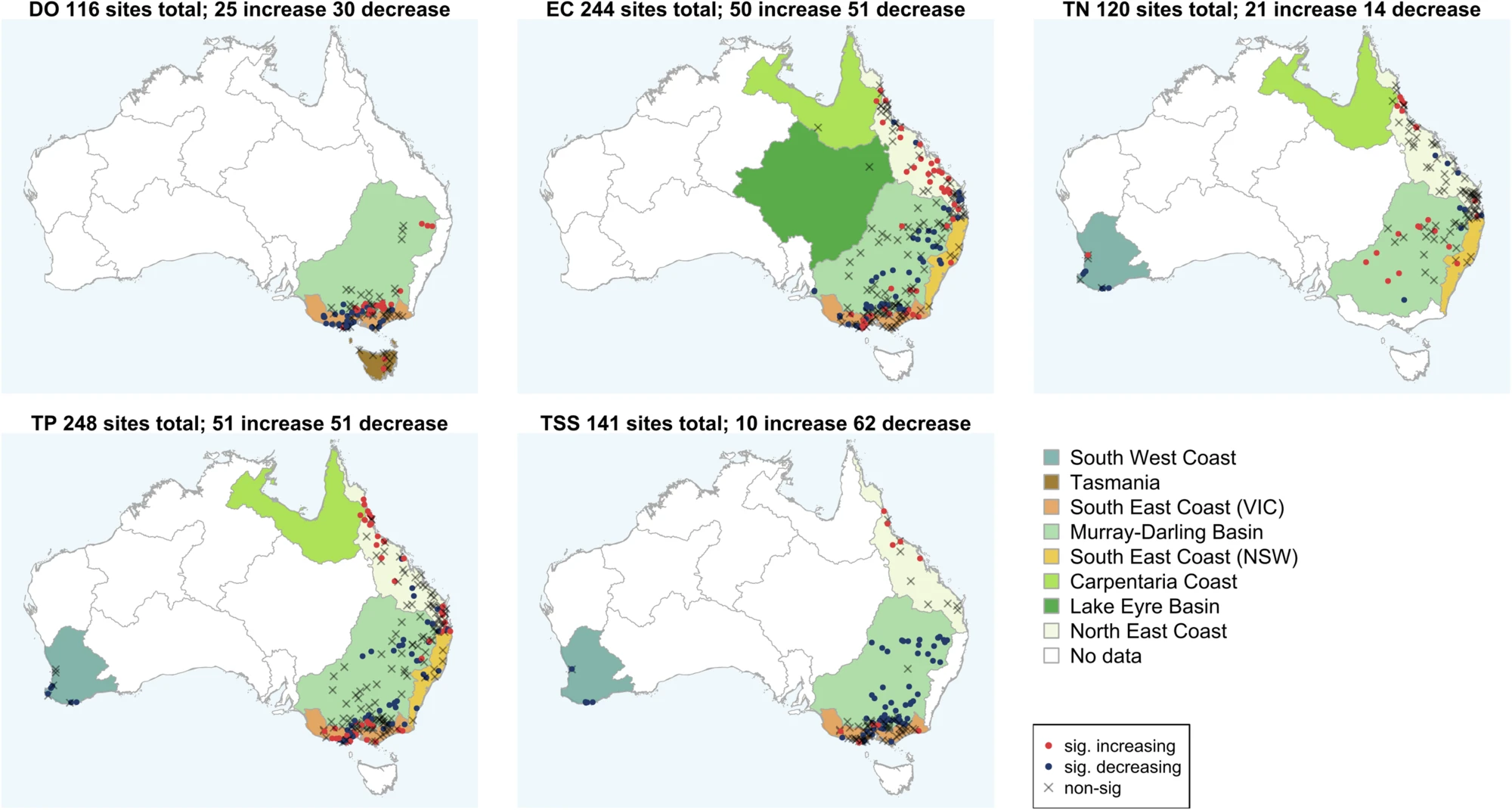How has Australia’s river water quality changed over two decades?
Published in Earth & Environment
Water quality is essential for water security and ecosystem protection and yet faces substantial challenges in the 21st century globally. Australia is no exception for this crisis, with water quality demonstrating significant impacts on society and the environment. But how do we tackle these challenges without understanding how water quality has changed over time? That’s exactly what inspired our research.
Join us as we dive into the data to uncover how Australia’s river water quality has evolved over the past two decades and whether there are any regional patterns in these trends. This trajectory of Australia’s river water quality is highly valuable for guiding future research and management.
We analysed changes in river water quality represented by the concentrations/values of five key parameters: electrical conductivity (an indicator of salinity), dissolved oxygen, total nitrogen, total phosphorus and total suspended solids (an indicator of sediments), from 2000 to 2019. A total of 287 river monitoring sites were analysed across the five parameters. The analysis used publicly available water quality monitoring data from individual Australian states and territories. The change in water quality between 2000 and 2019 for each site was estimated with the change in flow-normalised concentration, which was estimated by a statistical model, the Weighted Regressions on Time, Discharge, and Season (WRTDS). The model removed any noise from the water quality records due to interannual variability of streamflow, enabling us to focus on the overall change in water quality over two decades.
We found that between 2000 and 2019, about half of Australia’s catchments exhibit significant trends in each water quality parameter analysed. Within the catchments with significant trends, there are similar numbers of catchments showing increasing and decreasing trends for dissolved oxygen, salinity and phosphorus. Significant changes in nitrogen are dominated by increases (60% of catchments analysed), while significant changes in sediments are dominated by decreases (84% of catchment analysed). Most significant trends are not attributed to long-term changes in streamflow but instead, driven by other factors including changes in catchment processes, management and landscape changes.

Over the two decades, significant water quality trends also display distinct regional patterns. Australia’s largest river system, the Murray–Darling Basin, has generally experienced an overall improvement in water quality conditions, with most significant trends dominated by decreases in salinity, phosphorus and sediments. In contrast, the North East Coast region, which contain many rivers flowing into the Great Barrier Reef lagoon, is dominated by deteriorating conditions highlighted by predominantly significant increases in phosphorus and sediments. The deteriorating conditions for the North East Coast could be a lagged effect of land use intensification and clearing in the region during the 1960s and 1970s, while recent land management has yet shown clear effects in the reducing sediment and nutrient concentrations. For the Murray-Darling Basin, the overall reduction in salinity is likely a result of the regional salinity management intervention; while the decreases in phosphorus and sediments could be due to the Millennium drought which affected the region in the late 1990s and early 2000s. The long drought has potentially modified relevant catchment processes and changed the relationship between flow and water quality, reduced nutrient and sediment mobilisation to waterways.
Our study provides a national-level summary of the long-term water quality trajectories across Australia, which enables us to identify key regions and ‘hotspots’ of water quality deterioration that should be prioritised for future catchment management. Our findings also pinpoint potential regions exhibiting high risks of water security due to water quality concerns.
This study also highlights the geographical imbalances of water quality monitoring across Australia, with substantial underrepresentation of the arid and semi-arid regions, as well as northern and western Australia in general. Maintaining existing long-term monitoring while expanding their spatial coverage is essential to facilitate more comprehensive understanding of the nation’s long-term water quality trajectory.
Last but not least, our study suggests the importance of non-streamflow related drivers for the long-term water quality trends. However, detailed attribution of the water quality trends – such as quantifying the impacts from management versus catchment changes induced climate change – remains a challenging task due to the potential interactions between multiple water quality drivers. Further studies are needed to disentangle the potential impacts of management practices and changes in hydro-climatic conditions on water quality.
Follow the Topic
-
Communications Earth & Environment

An open access journal from Nature Portfolio that publishes high-quality research, reviews and commentary in the Earth, environmental and planetary sciences.
Related Collections
With Collections, you can get published faster and increase your visibility.
Geology of the Moon
Publishing Model: Hybrid
Deadline: Jan 31, 2026
Drought
Publishing Model: Hybrid
Deadline: Dec 31, 2025



Please sign in or register for FREE
If you are a registered user on Research Communities by Springer Nature, please sign in